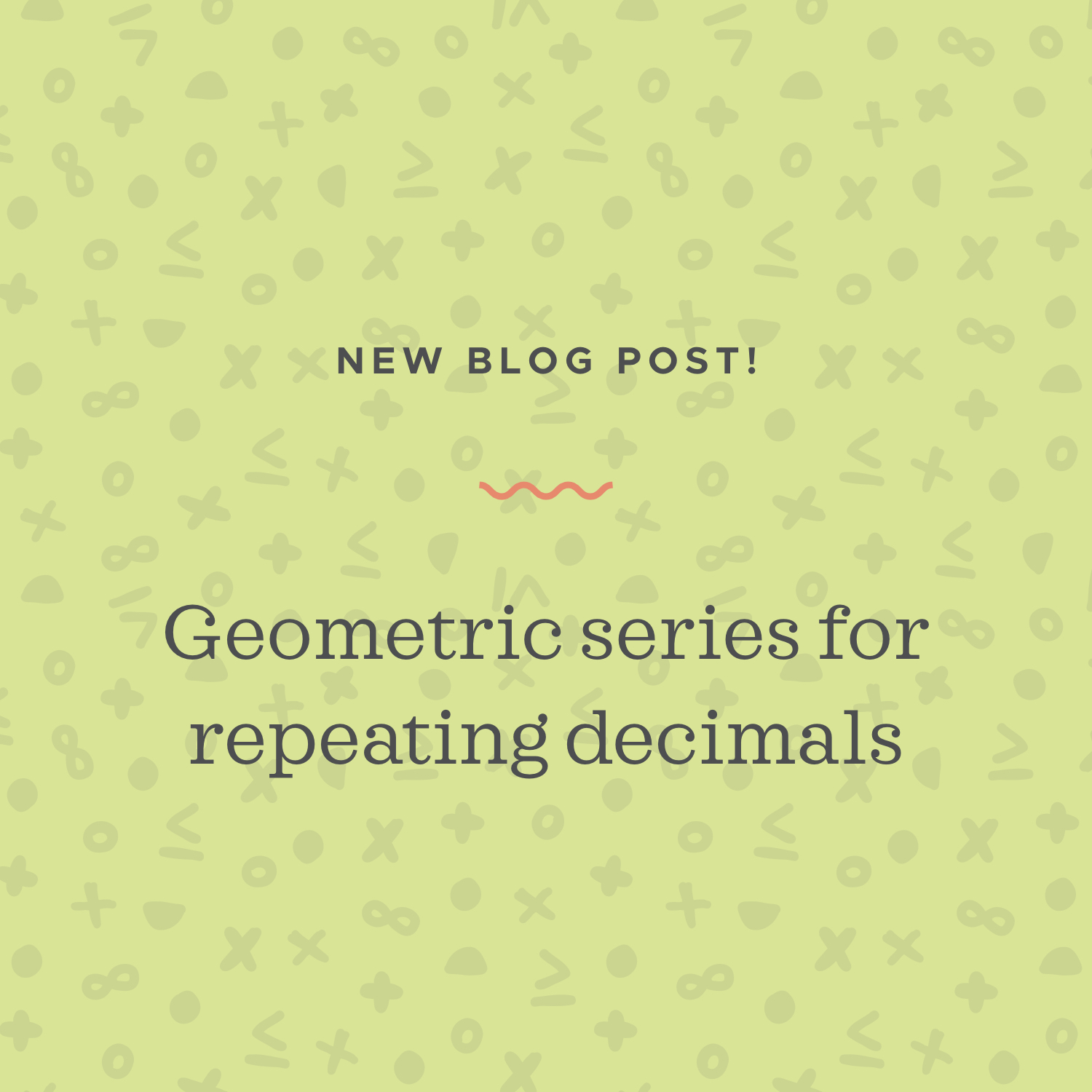Representing repeating decimals as a ratio of integers using a geometric series
Steps for turning a repeating decimal into a geometric series
We can use the formula for the sum of a geometric series to quickly and accurately convert a repeating decimal into a ratio of integers, in other words, into a fraction with whole numbers in the numerator and denominator.
Hi! I'm krista.
I create online courses to help you rock your math class. Read more.
We’ll follow these steps:
Separate the non-repeating part from the repeating part of the decimal.
In a table, match each repeated part with its last decimal place.
Create a sum of each part, dividing the repeated parts by their ending decimal places.
Identify the geometric series within the sum and set values for ???a??? and ???r??? from the formula for the sum of a geometric series, ???\sum^{\infty}_{n=0}ar^n=\frac{a}{1-r}???.
Use the formula to convert the series into one fraction.
Add this geometric series fraction to the fraction for the non-repeated part.
Representing a repeating decimal as a geometric series
Take the course
Want to learn more about Calculus 2? I have a step-by-step course for that. :)
How to express the repeating decimal as a ratio of integers by using a geometric series
Example
Express the repeating decimal as a ratio of integers.
???1.6\overline{73}???
The bar over the ???.073??? indicates that this is the portion of the decimal that repeats. This tells us that the decimal looks like
???1.673737373737373...???
We’ve been asked to convert this decimal value into a fraction with a real-number numerator and denominator.
Our first step is to separate the non-repeating part from the repeating part of the decimal.
???1.6+.073737373737373...???
We add a ???0??? in the tenths place of our repeating part because it’s holding the place of the ???.6??? we pulled out into the non-repeating part. The repeating sequence starts with the first ???7??? in the hundredths place, and we need to keep it there when we separate the decimals, so it’s critical to put in the ???0???.
Next, we’ll separate each part of the repeated sequence into its own row of the table below, replacing the decimal places before it with ???0???s. Once we’ve built out the left column, we’ll put the corresponding place in the second column.
We’ll create a sum of the non-repeated part and each of the repeated parts, dividing each repeated part by its ending decimal place.
???1.6\overline{73}=1.6+\frac{73}{1,000}+\frac{73}{100,000}+\frac{73}{10,000,000}+...???
The sum we just created is a geometric series, so we can use the formula for the sum of a geometric series
???\sum^{\infty}_{n=0}ar^n=\frac{a}{1-r}???
to turn the sum into just one fraction. We’ll factor out the first fraction from the repeated part.
???1.6\overline{73}=1.6+\frac{73}{1,000}\left(1+\frac{1}{100}+\frac{1}{10,000}+...\right)???
With our series in this form, we can identify ???a??? and ???r??? from the formula for the sum of a geometric series. ???a??? is always the value we factored that’s sitting right in front of the parentheses. ???r??? is the always the second term inside the parentheses, the value immediately following the ???1???.
???a=\frac{73}{1,000}???
???r=\frac{1}{100}???
a is always the value we factored that’s sitting right in front of the parentheses. R is the always the second term inside the parentheses, the value immediately following the 1.
Plugging these into the formula for the sum of a geometric series, remembering to keep the non-repeated part of our decimal, ???1.6???, we get
???1.6+\sum^{\infty}_{n=0}\frac{73}{1,000}\left(\frac{1}{100}\right)^n=1.6+\frac{\frac{73}{1,000}}{1-\frac{1}{100}}???
???1.6+\frac{\frac{73}{1,000}}{\frac{100}{100}-\frac{1}{100}}???
???1.6+\frac{\frac{73}{1,000}}{\frac{99}{100}}???
???1.6+\frac{73}{1,000}\cdot\frac{100}{99}???
???1.6+\frac{73}{10}\cdot\frac{1}{99}???
???1.6+\frac{73}{990}???
Now we just need to change the non-repeated part of our original decimal into a fraction and then combine these two fractions.
???\left(1+\frac{6}{10}\right)+\frac{73}{990}???
???\left(\frac{10}{10}+\frac{6}{10}\right)+\frac{73}{990}???
???\frac{16}{10}+\frac{73}{990}???
???\frac{99}{99}\left(\frac{16}{10}\right)+\frac{73}{990}???
???\frac{1,584}{990}+\frac{73}{990}???
???\frac{1,657}{990}???
If you have access to a calculator, you can always double-check yourself. In this case, just use your calculator to divide ???1,657??? by ???990???. If you did this correctly, you should get the original repeating decimal, ???1.6\overline{73}???.







